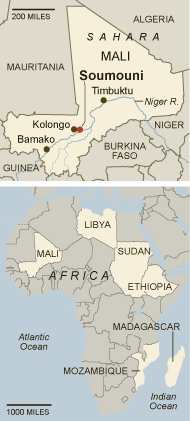
African Farmers Displaced as Investors Move In
New York Times,

SOUMOUNI,
“They told
us this would be the last rainy season for us to cultivate our fields; after
that, they will level all the houses and take the land,” said Mama Keita, 73,
the leader of this village veiled behind dense, thorny scrubland. “We were told
that Qaddafi owns this land.”
Across
Organizations like the
United Nations and the
World Bank say the practice, if done
equitably, could help feed the growing global population by introducing
large-scale commercial farming to places without it.
But
others condemn the deals as neocolonial land grabs that destroy villages, uproot
tens of thousands of farmers and create a volatile mass of landless poor. Making
matters worse, they contend, much of the food is bound for wealthier nations.
“The
food security of the country concerned must be first and foremost in everybody’s
mind,” said
Kofi Annan, the former United Nations
secretary general, now working on the issue of African agriculture. “Otherwise
it is straightforward exploitation and it won’t work. We have seen a scramble
for
A
World Bank study released in September
tallied farmland deals covering at least 110 million acres — the size of
Before
2008, the global average for such deals was less than 10 million acres per year,
the report said. But the food crisis that spring, which set off riots in at
least a dozen countries,
prompted the spree. The prospect of
future scarcity attracted both wealthy governments lacking the arable land
needed to feed their own people and hedge funds drawn to a dwindling commodity.
“You see
interest in land acquisition continuing at a very high level,” said Klaus
Deininger, the World Bank economist who wrote the report, taking many figures
from a Web site run by
Grain, an advocacy organization, because
governments would not reveal the agreements. “Clearly, this is not over.”
The
report, while generally supportive of the investments, detailed mixed results.
Foreign aid for agriculture has dwindled from about 20 percent of all aid in
1980 to about 5 percent now, creating a need for other investment to bolster
production.
But many
investments appear to be pure speculation that leaves land fallow, the report
found. Farmers have been displaced without compensation, land has been leased
well below value, those evicted end up encroaching on parkland and the new
ventures have created far fewer jobs than promised, it said.
The
breathtaking scope of some deals galvanizes opponents. In
People
have been pushed off land in countries like
In
“Even if
you gave the population there the land, they do not have the means to develop
it, nor does the state,” said Abou Sow, the executive director of Office du
Niger.
He
listed countries whose governments or private sectors have already made
investments or expressed interest:
In all,
Mr. Sow said about 60 deals covered at least 600,000 acres in
“What
advantage would they gain by investing in
As with
many of the deals, the money
“The
Libyans want to produce rice for Libyans, not for Malians,” said Mamadou Goita,
the director of a nonprofit research organization in
The huge
tracts granted to private investors are many years from production. But
officials noted that
Every
farmer affected, Mr. Sow added, including as many as 20,000 affected by the
Libyan project, will receive compensation. “If they lose a single tree, we will
pay them the value of that tree,” he said.
But
anger and distrust run high. In a rally last month, hundreds of farmers demanded
that the government halt such deals until they get a voice. Several said that
they had been beaten and jailed by soldiers, but that they were ready to die to
keep their land.
“The
famine will start very soon,” shouted Ibrahima Coulibaly, the head of the
coordinating committee for farmer organizations in
“Ante!”
members of the crowd shouted in Bamanankan, the local language. “We refuse!”
Kassoum
Denon, the regional head for the Office du Niger, accused the Malian opponents
of being paid by Western groups that are ideologically opposed to large-scale
farming.
“We are
responsible for developing
The
looming problem, experts noted, is that
“The
land is a natural resource that 70 percent of the population uses to survive,”
said Kalfa Sanogo, an economist at the United Nations Development Program in
Jon C.
Anderson, the project director, argued that no country has developed
economically with a large percentage of its population on farms. Small farmers
with titles will either succeed or have to sell the land to finance another
life, he said, though critics have said villagers will still be displaced.
“We want
a revolutionized relationship between the farmer and the state, one where the
farmer is more in charge,” Mr. Anderson said.
Soumouni
sits about 20 miles from the nearest road, with wandering cattle herders in
their distinctive pointed straw hats offering directions like, “Bear right at
the termite mound with the hole in it.”
Sekou
Traoré, 69, a village elder, was dumbfounded when government officials said last
year that
“All we
want before they break our houses and take our fields is for them to show us the
new houses where we will live, and the new fields where we will work,” he said
at the rally last month.
“We are
all so afraid,” he said of the village’s 2,229 residents. “We will be the
victims of this situation, we are sure of that.”